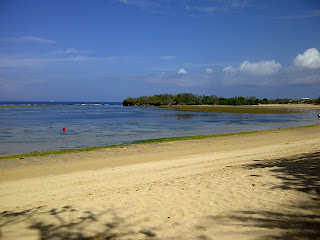Catch a Falling (sea) Star
Catch a falling star and put it in your pocket
Never let it fade away…
Catch a falling star and put it in your pocket
Save it for a rainy day …
Familiar with this song? Imagine catching a falling star and having it as your lucky charm. :-)
So I had a chance to catch some falling "stars". Nusa Dua Beach was full of them and I felt like I was in a Giant Touch Pool at the sea world. The two common species of sea stars that I found in Nusa Dua are the Horned Sea Star or also known as the Knobbly Sea Star (Protoreaster nodosus) and the Pentaceraster mammilatus. They come in various bright colors and shape. Some have horned or spiky feature, however, despite their scary-look, sea stars are safe to touch with the exception of the poisonous crown of thorn sea star(Acanthaster planci).
The features of sea stars are pentaradial symmetry and most of them have five arms that radiate from the central disk. Several species, such as the sunflower sea star (Pycnopodia helianthoides) and the crown of thorns sea star, have more than five arms. In school we learned that sea stars have the ability to regenerate lost arms and can regrow an entire new arm given time, but please note that not all sea star possess this superpower ability. So if you find a sea star, please handle it carefully and don’t try to break its arms in purpose just to see whether it can regrow.
The bodies of sea star are composed of ossicles, which are made of calcium carbonate. These formed the endoskeleton, which are externally expressed in various species as a variety of structures of spines or granules. Most sea stars prey on mollusk (snail, clam, oyster, etc), but some are also detritivores, means they feed on decomposing animal and plant material.
Here are some of the photos I took from a single trip to Nusa Dua Beach, Bali on October 2011.
 |
| a green knobbly sea star (Protoreaster nodosus) with the diameter size of 12 cm |
Protoreaster nodosus
This species of sea star also known as the horned sea star or knobbly sea star for the knobbly or horned feature on its aboral side. They are massive in size with a heavily calcified body wall and come in various color shade of red, orange, green or brown.
 |
| The oral or actinal side of the green Protoreaster nodosus. |
 |
| Not sure whether this is a Protoreaster nodosus or some punk kid of the sea :p |
 |
| The actinal side of the red Protoreaster nodosus. This sea star is 20cm wide in diameter. |
 |
| The color of knobs/ horns of the Protoreaster nodosus is darker then the rest of its body. |
 |
| A dark blue Pentaceraster mammilatus. |
Pentaceraster mammilatus
This species of sea star has smaller knob than the Protoreaster nodosus type. The knobs are more like granules and lighter in color than the color of it aboral side.
 |
| The oral/ actinal side of a Pentaceraster mammilatus. |
 |
| An orange Pentaceraster mammilatus with the diameter of less than 10cm. |
 |
| One pretty green Pentaceraster mammilatus with yellow tiny knob :) |
Gompohia gomophia (Gomphia gomphia)
 |
| Gomphia Sp. |
Gomphia Sp. has its aboral side covered with small knobbs which look like warts. On this trip, I found a three armed Gomphia Sp. Maybe it lost its two arms in an escape attempt from predator. Like lizard, some sea stars can perform autotomy, a self-defence mechanism where they detach their arm(s) to elude predator.
This Gomphia Sp. has one tiny arm that just started to regrow on its left side. I kinda feel pity for this little guy, but also fascinated at the same time.
 |
| An arm regenerating process in a Gomphia Sp. |




Comments
Post a Comment